In 1922, rather than printing a yearbook, the graduating class elected to create a “Senior Yearbook” in the brand new student newspaper, then called The Oriole. In that issue are the first photos of the Maryland State Normal School’s (MSNS) athletic teams, namely the “basket ball teams” for that year. None of the players are identified in the photos.
While the school had always offered some version of physical education — often called calisthenics or physical training — in 1919, with a grant from the U.S. government, the school was able to put instructors into place for the first time. The move to a campus with housing meant that more students would have time and ability to play sports outside of any required class. And in the 1921/1922 academic year, the school created an Athletic Association. That year, the total enrollment for the school was just under 400 students — and only 20 of those students were men. While the school that would become Towson University focused on teacher training, male enrollment would always be much lower than female enrollment.
Which is why the story of what happens with women’s athletics at Towson is such a strange story.
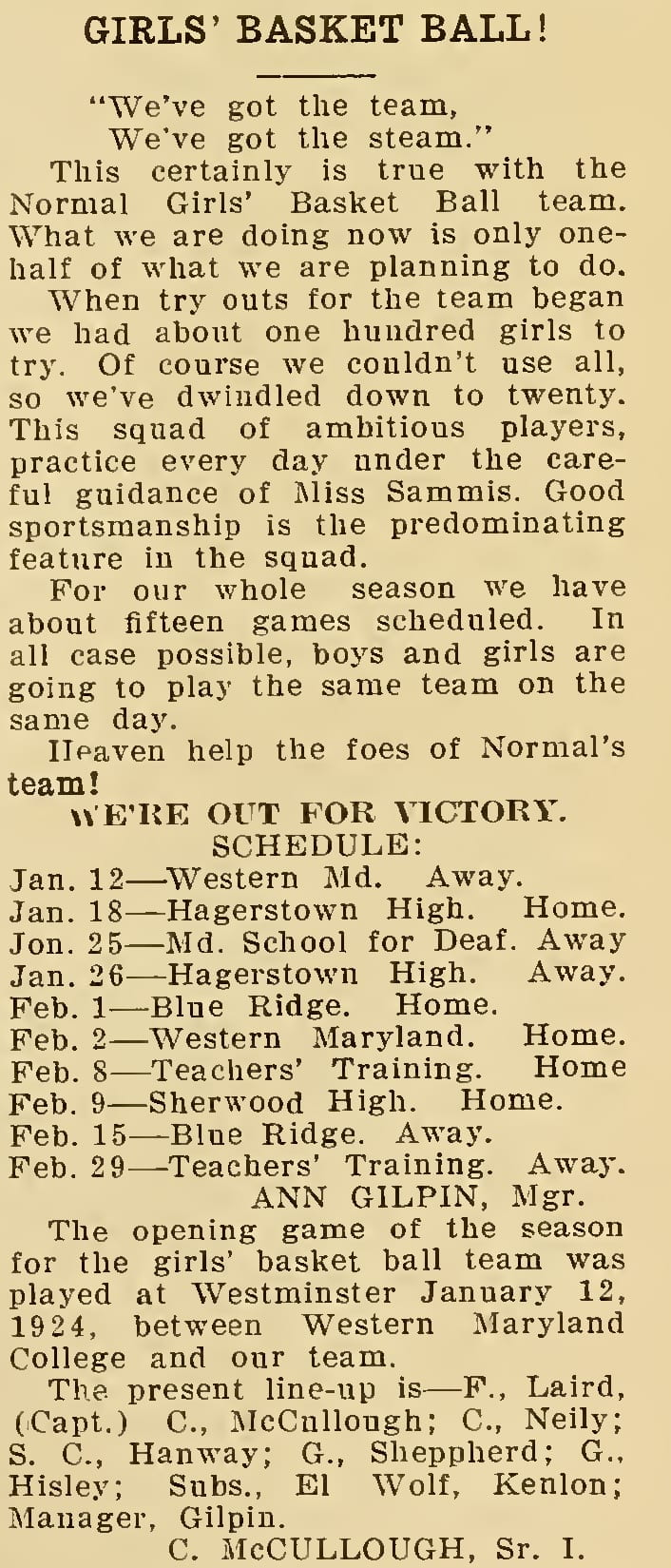
In the 1920s, both male and female teams — girls and boys, as they were known in the vernacular of the day — played games with a variety of opponents. They were just as likely to play against area high schools as they were to play other training schools and colleges. This is most likely because until the 1930s, the curriculum at MSNS was only two years. One could argue that you can’t develop a strong varsity system if students are only in school for two years. In 1922, a co-educational Athletic Association was created and every person who went to MSNS was a member, but only students who participated in sports were considered “active”. It seems those students paid a fee, sometimes a dollar for the entire year, and that money went to improving equipment and fields.
The teams lost as often as they won, and mostly the student newspaper, which became The Towerlight in 1926, recorded scores, encouraged attendance at games, and noted the hospitality of competitors, especially during overnight trips.
In 1926, however, it was decided that women’s teams would no longer face off-campus opponents. The October Towerlight reported:
It is no new thing to be told that there will be no interscholastic games for the girls this year at Normal School. Don’t be discouraged, it is a time in which the best sportsmanlike side of every one is called forth. Put your whole hearts and souls into your section games, and into your year games and make them count. Come out to the different practices with the same enthusiasm as you have shown before.
The focus for sports was now directed to the men’s teams and particularly towards the major sports the men played: soccer, basketball, baseball, and tennis. Women instead played various sports as electives — against each other at MSNS and the iterations of the school that followed. These intramural games between classes would be the norm for almost the next half-century.
While the Athletic Association was at first a co-educational organization, once the women were no longer allowed to play other schools, weight — and money — was given to the men’s teams and equipment needs.
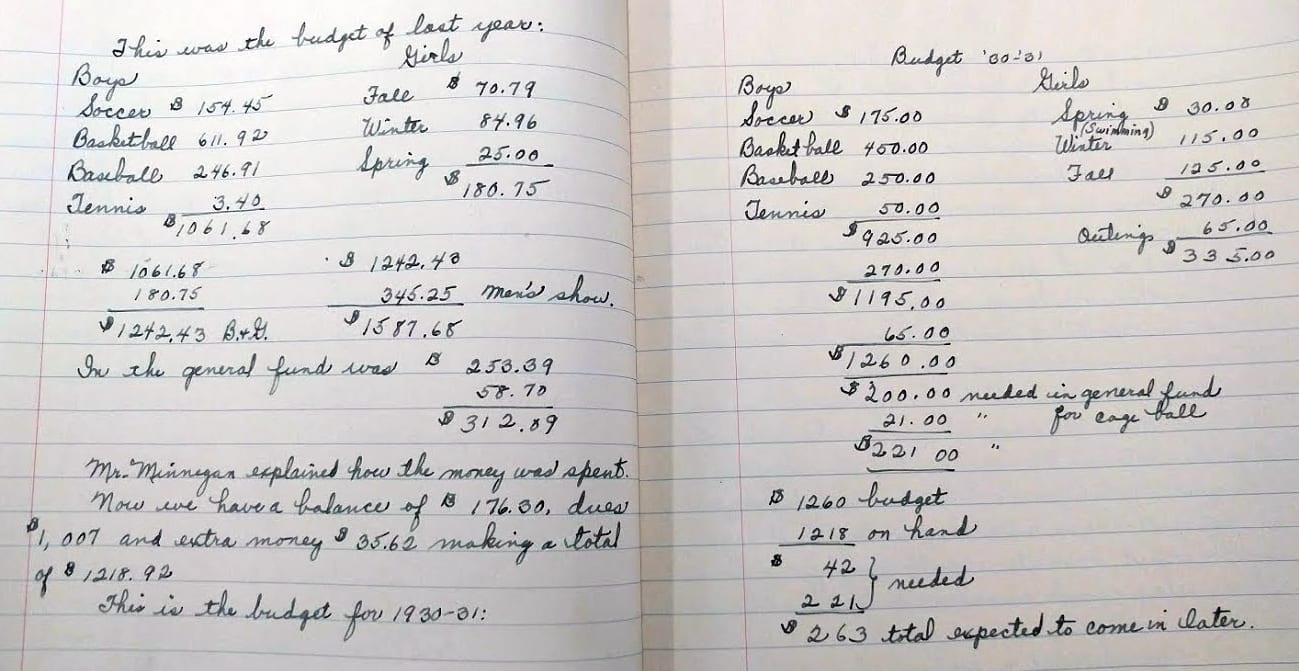
The Athletic Association itself split and the Women’s Athletic Association (WAA) spent most of their meeting times discussing how awards would be designed and distributed. They hosted an intramural Play Day: classmates could join together and compete in various sporting events.
The WAA was also expected to create entertainment events, rather than just compete in sports.
Demonstration Night started in the 1930s and was a way for women students to showcase their talents in some sports, but mostly in dance, acrobatics, and teamwork. Dinner tickets were sold as a fundraising effort.

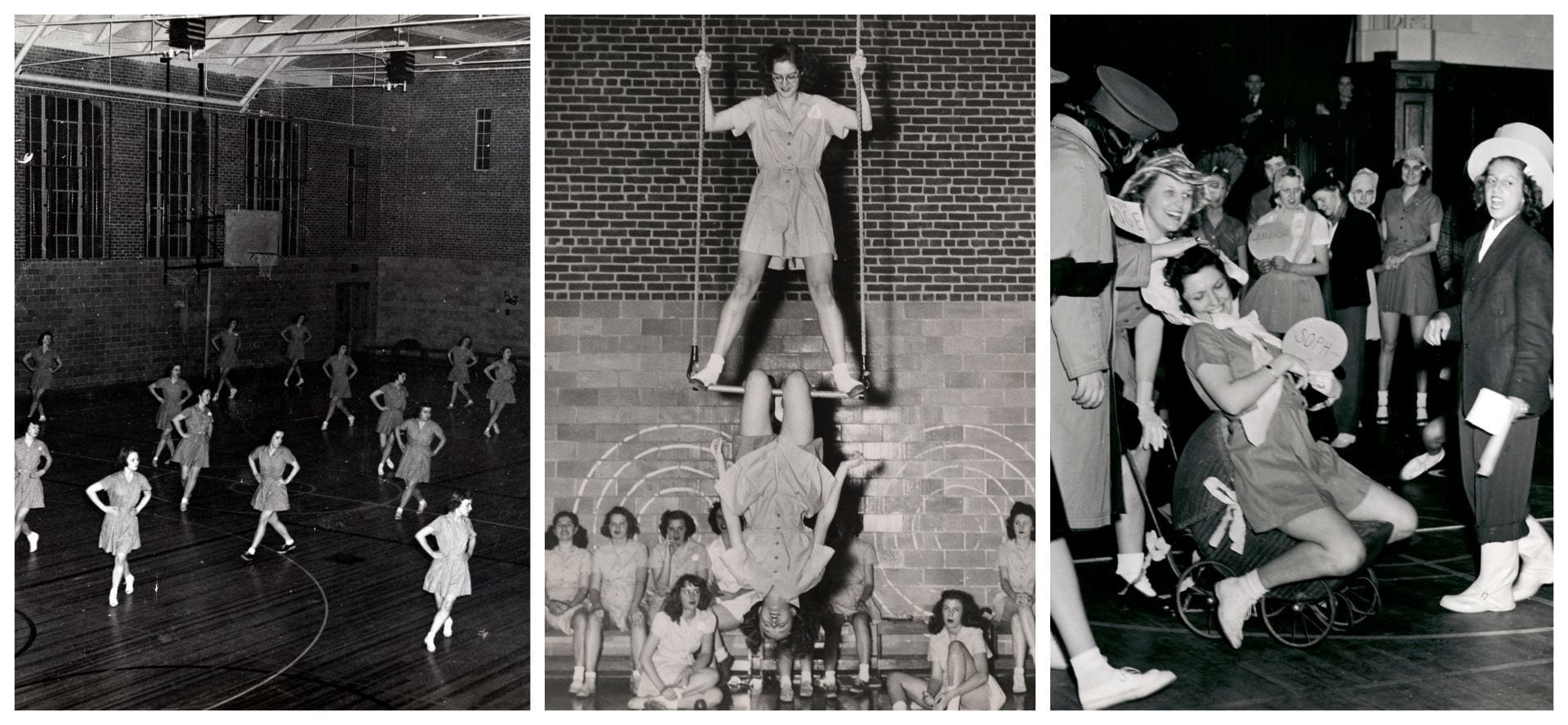
In April of 1940, the Towerlight opined:
Many people wonder why the girls do not have a varsity basketball team. The girls themselves admit it would be fun, but there are reasons why they are content with things as they stand. In the first place, there is not enough money for a girls’ varsity team. You may think there is no expense connected with it, but the amount of money which can be spent is surprising. To begin with, there must be good equipment. No team can win with balls that are showing their age. Then, too, there is the expense of actually conducting a game with another college. A referee must be hired (fifteen dollars per game is the usual charge), transportation must be arranged, and visiting teams must be given their dinner in the dormitory (thirty-five cents for each person). Then of course, there would be the question of uniforms.
But not all women agreed. After a 1941 Play Day held at College of Notre Dame of Maryland, now known as Notre Dame of Maryland University, WAA members told the Towerlight, “Girls need to go out for competition. Boys compete with other colleges. Why can’t we? We should become better acquainted with other schools.”
By 1942 the United States had entered WWII. Most of the male students would be drafted or enlisted, and everyone who remained on campus focused on supporting the war effort and finishing their coursework as quickly as possible. There was a teaching shortage and with so many people joining the armed forces or finding government work, the school struggled to keep enrollment up.
Meanwhile, students in the WAA continued to advocate for more sports events between other area schools. The intercollegiate Play Day continued through the war years and beyond. In 1943, the day was used to celebrate the opening of the new gymnasium on campus, which would later be called Wiedefeld Gymnasium.
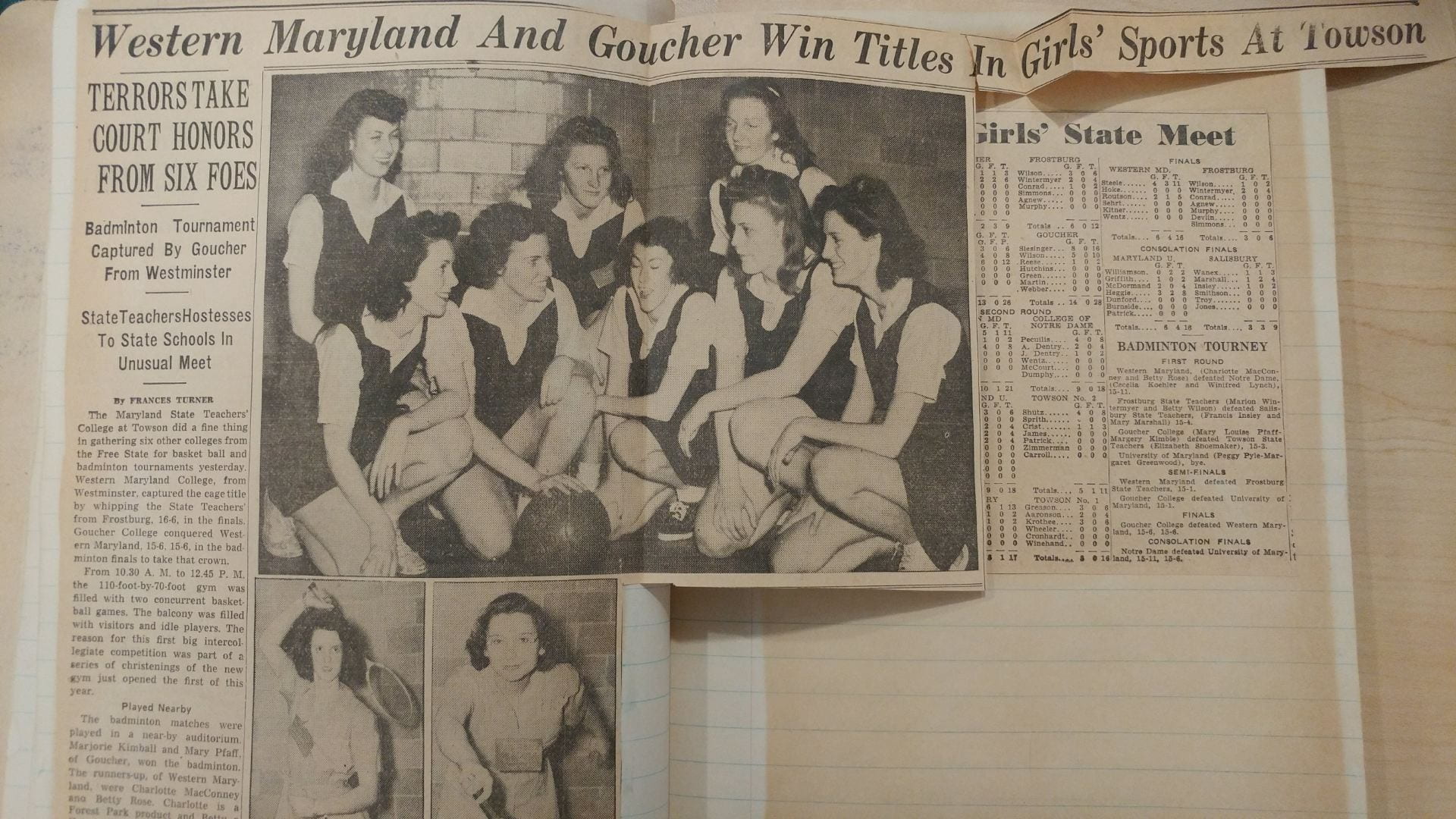
During the war years, school was often in session during the summer as well, so teachers could train in three years instead of four and fill badly needed positions during a teachers’ shortage. In 1943, the WAA sponsored a school-wide outing to the LaMotte pool and even supplied hot dogs, rolls, and potato chips for dinner.

With the increase in intercollegiate athletics, women were not as interested in participating in the display that was Demonstration Night, and it was eventually discontinued. With the men at war, there wasn’t the same strain on equipment purchases for all sports that there had been in the past. Women met regularly to play against other schools in a wide variety of sports including badminton, volleyball, softball, and tennis.
After the war, things mostly returned to the way they had been in 1941, which caused frustration among the women students.
A male opinion writer for the Towerlight suggested that while women wanted more consideration when it came to sports, that they weren’t advocating for themselves:
The population of girls on this campus numbers over 400 and it seems that there should be some girls with enough initiative to get up and demand what they think they are entitled to. Certainly the handful of men at Towson fight and ask for what they want. What is the matter, girls? Is the President of the Women’s AA deaf to your pleas for letters? Are you afraid of your coach? Where is that do-or-die spirit displayed in so many of your hard-fought contests this past fall? Come on, let’s get organized.
In the WAA minutes from May 20, 1947, there was a discussion about funding. The WAA president “brought out the fact that the WAA does not need the same amount of money as the MAA [Men’s Athletic Association] due to the fact that the program of the WAA is entirely different from that of the MAA.” The notes go on to say the faculty advisor, Miss Roach, “discussed the general program of the WAA and explained why we could not have varsity teams.”
In essence, women weren’t speaking up because the very organizations and mentors who were supposed to champion them were not.
One thing that did change, however, was that women continued to play other schools in certain sports like basketball and field hockey rather than just playing between classes or other intramural competitions.
In January of 1958, the Towerlight reiterated the stance of women’s teams at STC: “As is the policy at S.T.C. there will be no designated Varsity or Junior-Varsity, but simply a group of girls who display an earnest desire to represent their school in the sports program.” But the article went on to say “It is interesting to note that with such a policy, the girls basketball teams last year boasted a ten and one record defeating such teams as Goucher, Western Maryland, Villa Julie, Mt. St. Agnes, Union Memorial Nurses, Baltimore University, Salisbury and St. James.”
Basketball became something of an outlier in women’s sports. While other sports continued as electives, basketball was held both as an elective sport, and then the best basketball players would be chosen to play on the “Interscholastic Basketball Team” which was the one that competed against all those schools. This team would be split into the “A” team and “B” teams.
And as the school transitioned from a teacher’s college to a liberal arts school, this would suggest that there would be future tensions about money for athletics. If STC, now Towson State College (TSC), attracted more male students, then there would be a call for more men’s teams, again impacting the amount of financial support women could expect to receive.
However, by 1968, women’s basketball teams, now called the “Tigerettes”, would be split into varsity and junior varsity teams. Intramural basketball was still organized by the WAA, but varsity and JV players were only allowed to officiate at those games, not play.
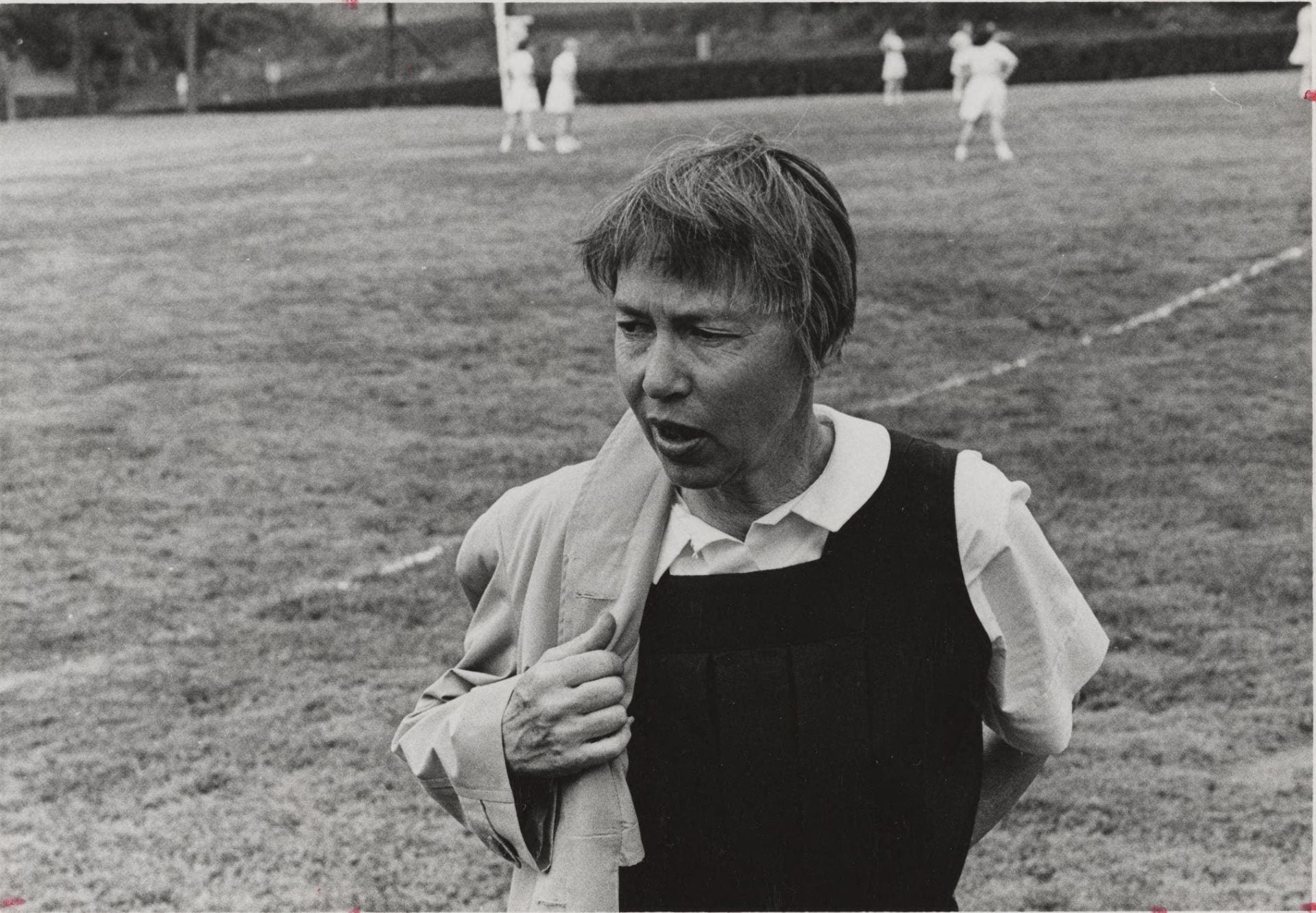
In 1968, a team from TSC competed in the first women’s National Invitational Tournament. They lost to Southern Illinois, but managed to defeat Ball State, Central Michigan, and Purdue. The team and their coach, Margo VerKruzen, were inducted into the Towson Hall of Fame. The only other women’s team in the Hall of Fame from that early in Towson’s history is the 1969 gymnastics team. They were the first to win a national championship in any sport for Towson.
The WAA was still entertaining — creating floats, hosting Play Days, and offering refreshments. But women’s sports had evolved beyond what the WAA supported. By 1972, when Title IX mandated that schools provide equally for men’s and women’s sports, the need for the Women’s Athletic Association had fallen away.
But the legacy of men’s only varsity sports has definitely made an impact on Towson University’s sports history. Of the 32 teams in the Hall of Fame, only 7 are women’s teams. There are 230 individual members of the Hall of Fame, but only 58 are women — that is only 25% of the total. There are 48 basketball players in the Hall of Fame, but only 8 of them are women. No women’s basketball player has been inducted into the Hall of Fame since 2004. The earliest player, Ann Rogers Ridenour, Class of 1957, was noted for having played three sports in her career at Towson.
This month, Diane Richardson, the women’s basketball coach, has been named the Colonial Athletic League’s 2018-19 Coach of the Year, and the team is having a great season.
For almost 100 years, women have been playing basketball at Towson University. We hope that future teams continued to be recognized for their successes.
